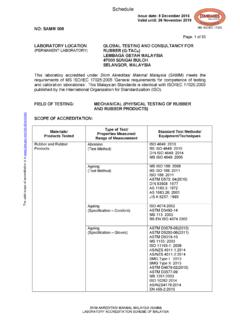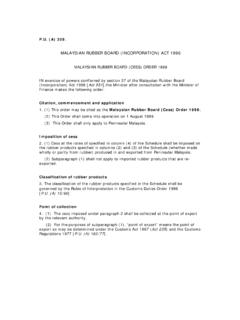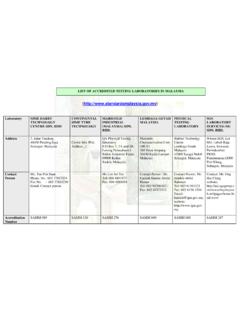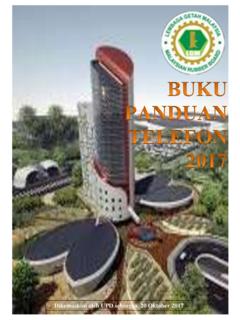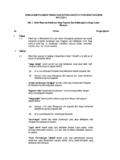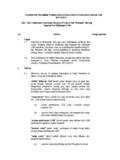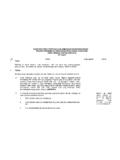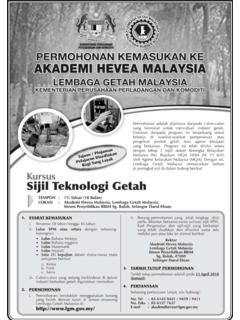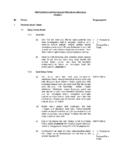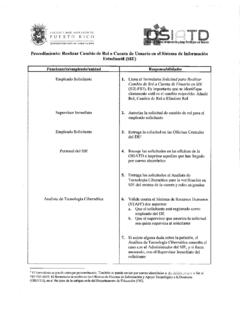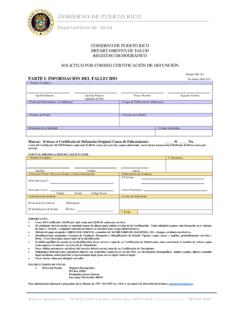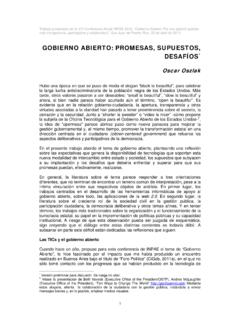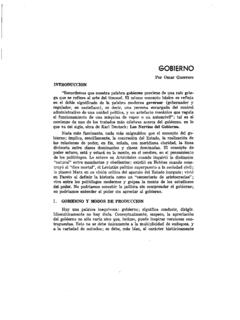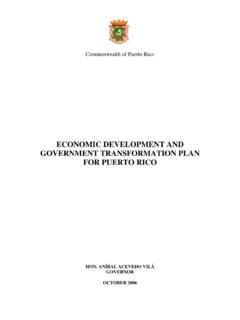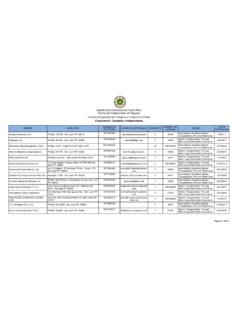Transcription of The Malaysian Natural Rubber Industry
1 The Malaysian Natural Rubber Industry In the last decade, the world NR Industry has undergone very rapid and fundamental changes with the appearance of many new players, in particular the growth of some traditional suppliers and the emergence of new ones. Much of the changes and consequent challenges, both internally and externally, have impacted on Malaysia's comparative and competitive advantage in NR cultivation. Notwithstanding this, the Malaysian Rubber Industry has evolved through the years and transformed itself into a more integrated Industry where the rapid developments of the mid- and downstream industries have made the Industry a multi-billion ringgit one.
2 This was vastly aided by the introduction of the three Industrial Master Plans which gave greater impetus to the growth of the Rubber and rubberwood manufacturing sectors. The Rubber cultivation Industry or the upstream sector became a major raw material supplier to two value-added resource-based industries. With this development, the competitiveness of the Rubber Industry as a whole has been greatly enhanced. Another positive factor that cannot be overlooked is Malaysia s advantage as the foremost authority on R&D in all aspects of NR.
3 This technical advantage has enabled Malaysian producers to accelerate productivity through the application of new planting, exploitation, processing and manufacturing technologies. Competitiveness of the Rubber products sector The Rubber products manufacturing Industry has achieved remarkable progress with the launching of the IMPs in terms of Rubber consumption and export earnings. In the last seventeen years (1990-2007) total Rubber consumed by the Industry increased by 209% from 187 592 tonnes to 579 248 tonnes, of which NR was the main material used.
4 Malaysia is now the fifth largest consumer of NR in the world after China, the USA, Japan and India and also the biggest consumer of NR latex. Malaysia is also the world's largest producer of latex gloves, catheters and latex thread. In tandem with the increase in Rubber consumption, the corresponding increase in the volume and value of exported Rubber products has also grown significantly. Export earnings of the Industry expanded by from RM billion in 1990 to RM billion in 2007. It is significant to note that the bulk of the earnings were attributed to the latex-based sub-sector, in particular gloves.
5 Competitiveness of the rubberwood sector The rubberwood products sector developed concurrently with the Rubber products sector, both being the two resource-based industries identified under the IMPs. The commercial utilisation of rubberwood has been successfully accepted as an alternative timber to the Natural forest species for products such as mouldings, furniture and carpentry. In addition, rubberwood is also being used as the raw material for the manufacture of particleboard, medium density fibreboard, wood-cement board and plywood.
6 The Industry has grown by leaps and bounds in recent years with the rising popularity of rubberwood furniture in the major developed countries. Rubberwood sawntimber is mainly used by the furniture Industry and about 80% of the total wood furniture exported from Malaysia come from rubberwood. The Industry has made extensive investments in terms of machinery, R&D and designs in order to maintain its share in existing markets and to penetrate new ones. With the introduction of the Latex Timber Clones (LTCs) in the late 1980s, the prospects for the value-added sectors of the Rubber Industry were greatly enhanced.
7 The popularity of rubberwood furniture and the consequent demand for rubberwood soared especially when its nearest compatible wood, ramin, came into short supply. Since replanting was a regular annual exercise, the supply of rubberwood was quite consistent and relatively cheap. Despite the fact that rubberwood furniture has very high value-added features, the price of Rubber logs has remained low. This has contributed to the competitiveness of the rubberwood furniture Industry in the face of similar semi hardwoods in the market.
8 The maximisation of wood output can be obtained from planting Rubber forest plantations based on the 15-year cycle. Investors have a choice of either planting Rubber for its latex and wood or for wood alone since the demand for both are potentially high. Other competitive factors R&D Support The extensive R&D infrastructure developed under the RRIM and the LGM systems over the last seventy five years has made it the world s largest and most comprehensive R&D set up for a single commodity. The Tun Abdul Razak Research Centre (TARRC) in the United Kingdom deals mainly in R&D on the consumer end, end-use research activities.
9 Over the years, the Rubber Industry has accumulated a pool of expertise on all scientific aspects of NR in the areas of plant science, agronomy, plantation management, processing, Rubber and Rubber products technology, rubberwood furniture design and manufacturing and overall marketing. This wide pool of expertise is complemented by the in-house R&D facilities available in the larger plantation agencies in the private sector. Collaborative work between the two sectors has contributed to the rapid growth and development of the Industry especially with the introduction of a hands-on approach by the MRB in instilling new technologies for adoption in private sector Rubber product manufacturing companies which consist mainly of SMIs.
10 The strong R&D and technical support give greater confidence to the Industry and provides a competitive edge for the development of the various sectors in the face of competition from the other major producing countries. Environment The rising tide of environmental consciousness has put Rubber cultivation in favourable light. Atmospheric pollution from the release of 'greenhouse gases', especially carbon dioxide, from the combustion of fossil fuels and the depletion of forests, especially the tropical rain forests, have been viewed with great concern.
